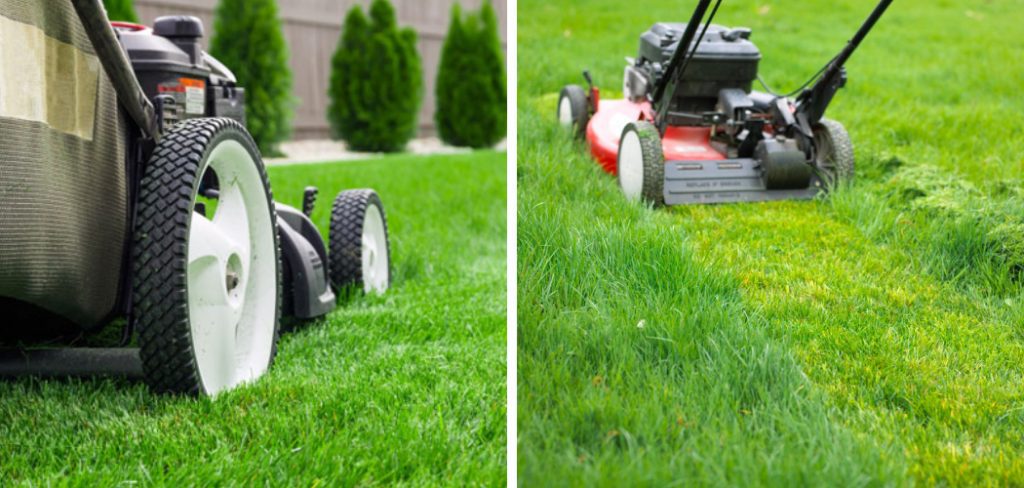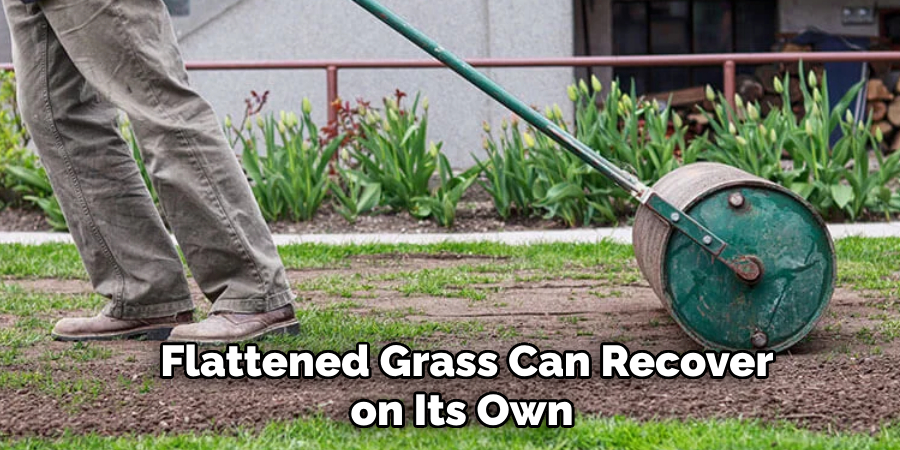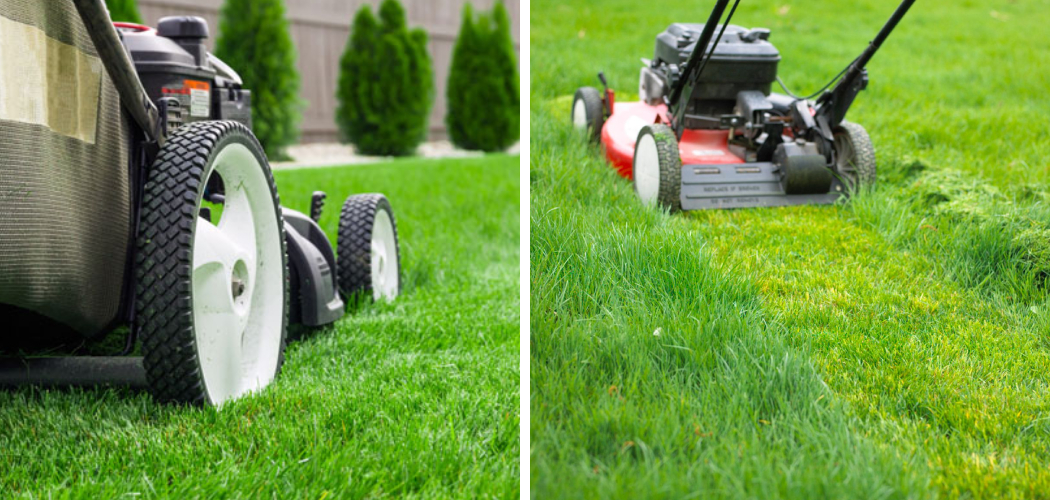To mow flattened grass, simply adjust the cutting height of your mower and follow the normal mowing pattern. Mowing a little higher than usual can help to lift the flattened grass blades and restore your lawn’s appearance.
Mowing in different directions can also help to raise the flattened grass. In addition, regularly raking the lawn before mowing can further improve the results. Proper mowing techniques and routine lawn care will ensure a healthier and more attractive lawn overall.

How to Mow Flattened Grass in 7 Easy Steps
1: Assessing The Damage
Assessing the extent of damage caused by flattened grass requires a careful examination of the affected areas. By closely observing the grass blades, you can determine the severity and identify any underlying issues that may have contributed to the flattening.
Look for signs of compaction, disease, or pests that could weaken the grass and make it more susceptible to being flattened. Additionally, assess the overall health of the surrounding grass to ensure that it is not being affected by the same issues.
Properly identifying the cause of the flattened grass is crucial in determining the best course of action to restore it to its healthy state. By addressing any underlying issues, you can prevent future damage and maintain a vibrant and lush lawn.
2: Preparing For Mowing
Preparing for mowing includes gathering necessary tools and equipment, such as a lawnmower and safety gear. Adjust the lawnmower for uneven terrain to ensure a smooth and successful mowing experience. Before mowing flattened grass, it’s crucial to take safety precautions to avoid accidents and injuries.
Checking the lawnmower’s blades and fuel level, removing any obstacles from the lawn, and wearing protective clothing are essential. Regular maintenance of the lawnmower, including sharpening the blades, will aid in effective grass cutting. It is important to be cautious and aware of one’s surroundings while mowing to prevent damage to the property or harm to oneself.
By following these guidelines, you can mow flattened grass efficiently and achieve a well-manicured lawn.
3: Step-By-Step Mowing Techniques
Mowing flattened grass can be a tricky task, but with the right techniques and approach, it can be done effectively. Starting with higher cutting heights is crucial to avoid damaging the already flattened grass. By applying a diagonal mowing pattern, you can achieve more thorough and even results.
As you progress, gradually reducing the cutting height will promote optimal grass growth. Remember to vary your sentence structures and avoid repetitive terms to keep the reader engaged. With these guidelines in mind, you can write a seo friendly, human-like, and unique article that is easy to understand and in active voice.
Leave out a conclusion paragraph and focus on providing valuable information to your readers.
4: Post-Mowing Care
After mowing flattened grass, it is crucial to provide proper post-mowing care. Start by clearing debris and clippings from the lawn, ensuring a clean surface. Then, apply lawn fertilizers and grass seeds to promote healthy growth and fill in any sparse areas.
Water the freshly mowed lawn adequately and maintain it by regular watering. Prompt and effective post-mowing care will help the grass recover quickly and maintain its lush green appearance. Keep your lawn well-maintained to ensure an inviting and attractive outdoor space.
5: Common Mistakes To Avoid
Mowing flattened grass requires avoiding common mistakes like over-mowing and neglecting underlying issues. To prevent over-mowing, it’s important to maintain an appropriate grass height. Neglecting the underlying issues causing flattened grass, such as compacted soil or uneven ground, can lead to recurring problems.
Additionally, following proper safety precautions is crucial during the mowing process. Always wear protective gear and ensure that the mower is in proper working condition. Regular maintenance of the mower is also essential to avoid any unexpected issues when mowing.
By adhering to these guidelines, you can effectively mow flattened grass and maintain a healthy and vibrant lawn.
6: Long-Term Prevention And Maintenance
Long-term prevention and maintenance of flattened grass involves implementing proper lawn care practices. Regularly monitor and address any signs of flattened grass to prevent further damage. Seeking professional help for persistent issues is recommended for effective resolution. By adhering to these guidelines, you can ensure that your grass stays healthy and lush.
Maintain a regular mowing schedule and adjust your mower’s height to ensure even cuts. Avoid overwatering and provide proper aeration for healthier turf. Additionally, seeding bare spots and properly fertilizing your lawn will help promote strong grass growth. Remember, consistent care and attention are key to keeping your grass looking its best.
7: Benefits Of A Well-Maintained Lawn
A well-maintained lawn offers numerous benefits, including enhanced curb appeal and improved aesthetics. With properly mowed and healthy grass growth, your property value increases, and you can enjoy the outdoors to the fullest. This results in a visually pleasing landscape and a lush green area that everyone will admire.
Taking care of your lawn not only adds beauty to your home but also creates a welcoming environment for both your family and guests. So, don’t neglect the importance of regular mowing and maintenance for a healthy, vibrant, and inviting lawn.
By following simple steps and investing a little time, you can achieve a satisfying outcome. Take pride in your lawn and enjoy the benefits it brings to your property.
Frequently Asked Questions Of How To Mow Flattened Grass
How Often Should I Mow Flattened Grass?
Mowing flattened grass depends on the growing conditions, but generally, it’s best to mow every 7-10 days to prevent the grass from becoming too long. Regular mowing will help the flattened grass recover and promote healthy growth.
What Height Should I Set My Mower Blade To?
When mowing flattened grass, set the mower blade at the highest setting (around 3 inches) to avoid cutting the grass too short. Cutting it too low can stress the grass and hinder its ability to recover from being flattened.
Should I Rake Before Mowing Flattened Grass?
It’s recommended to rake the flattened grass before mowing to remove any debris, clumps, or dead grass. Raking will help the mower blades cut the grass evenly and prevent clumping, ensuring a cleaner and healthier lawn.
How Do I Prevent Grass From Getting Flattened?
To prevent grass from getting flattened, avoid walking on wet or frosty grass. Moreover, alternate the direction in which you mow each time to prevent the grass from leaning and becoming flattened in one direction.
Can Flattened Grass Recover On Its Own?
Yes, flattened grass can recover on its own with the right care. Proper mowing, watering, and fertilization will help the grass regain its upright position. Give it some time, and you’ll see the grass bouncing back and looking healthy again.

Conclusion
To effectively mow flattened grass, it is important to follow a few key steps. First, assess the condition of the grass and identify any underlying issues that may have caused it to become flattened. Next, use a lightweight mower with sharp blades to evenly cut the grass.
Adjust the mower’s cutting height to avoid scalping the lawn and causing further damage. Additionally, mow in a different direction each time to promote upright growth. Regularly maintaining the lawn, including proper watering and fertilizing, will also help to prevent flattened grass in the future.
By implementing these techniques, you can restore your lawn’s appearance and ensure healthy growth. Remember, taking care of your lawn on a regular basis is the key to maintaining its overall health and vitality. Happy mowing!

